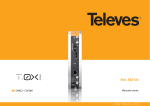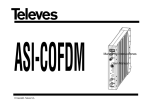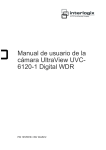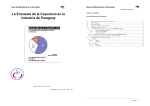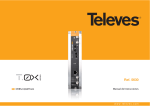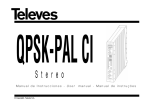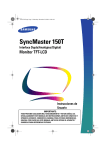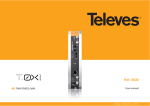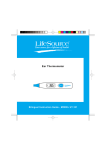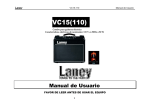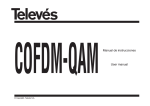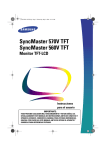Download Ref. 563101 - C2D Technology
Transcript
Ref. 563101 ES EN DVBS2 - COFDM DVBS2 - COFDM Manual de Instrucciones User manual w w w. t e l e v e s . c o m DVBS2 - COFDM Índice 6. 7. 8. 9. Características técnicas ..................................................................................................................... Descripción de referencias ................................................................................................................. Montaje ............................................................................................................................................... 3.1. Montaje en libro ........................................................................................................................... 3.2. Montaje en rack 19” .................................................................................................................... Descripción de elementos .................................................................................................................. 4.1. Introducción ............................................................................................................................. 4.2. Fuente de alimentación ............................................................................................................ 4.3. Central amplificadora .............................................................................................................. 4.4. Programador universal ............................................................................................................. Instrucciones de uso .......................................................................................................................... 5.1. Menú normal ............................................................................................................................ 5.2. Menú extendido ........................................................................................................................ Control del dispositivo ....................................................................................................................... Ejemplo de distribución de 7 canales de DVBS2-COFDM T0X ......................................................... Normas para montaje en rack ............................................................................................................ Normas para montaje en cofre ........................................................................................................... 5 7 8 8 9 10 10 11 12 13 14 14 16 18 20 21 23 A. Tabla de canales ................................................................................................................................. 47 4. 5. ES ESPAÑOL 1. 2. 3. 5 1. Características técnicas 1.1. DVBS2-COFDM Desmodulador Satélite Modulador COFDM Salida RF General ref. 563101 Frecuencia de entrada: 950 - 2150 MHz Pérdidas de paso: < 1,5 dB tip. Velocidad de símbolo: 10-30 Mbaud (QPSK- 8PSK) Modulación: DVB-S2 (QPSK, 8PSK) DVB-S (QPSK) Pasos de frecuencia: 1 MHz FEC interno: LDPC (9/10, 8/9, 5/6, 4/5, 3/4, 2/3, 3/5, 1/2, 1/4, 1/3, 2/5) Conectores de entrada y salida: “F” hembra FEC externo: BCH (Bose-Chaudhuri-Hocquenghem) Impedancia de entrada: 75 ohm. Factor de roll-off 20%, 25%, 35% Alimentación LNB: 13/17V/ OFF 22KHz (ON/OFF) R.O.E. entrada: 10 dB min. Formato de modulación: QPSK, 16QAM, 64QAM Scrambling: DVB ET300744 Intervalo de guarda: 1/4, 1/8, 1/16, 1/32 Interleaving: DVB ET300744 FEC: 1/2, 2/3, 3/4, 5/6, 7/8 Cell_id: Seleccionable Ancho de banda: 7 MHz, 8 MHz Espectro de salida: Normal / Invertido (Selec.) Frecuencia de salida: 45- 862 MHz 474 - 858 MHz (UHF) Pérdidas de paso: < 1,5 dB tip. Pasos de frecuencia: 166 KHz Pérdidas de retorno: > 12 dB tip. Nivel máximo de salida: 80±5 dBμV (progr.) Conectores de entrada y salida: “F” hembra. Atenuación: >15 dB (prog) Impedancia de salida: 75 ohm. Alimentación: 24V Consumo 24V: 300 mA Indice de protección: IP20 Las características técnicas descritas se definen para una temperatura ambiente de 40°C (108ºF). Para temperaturas superiores se utilizará ventilación forzada. ES DVBS2 - COFDM 6 1.2. Características técnicas Centrales Central 5575 Central 451202 (1) Canal principal Rango de frecuencia: 46 ... 862 MHz Conector: Ganancia: 44 ± 2,5 dB Alimentación: “F” Margen de regulación: 20 dB Consumo a 24 V Tensión de salida (60 dB): 105 dBμV (42 CH CENELEC) Toma de test: -30 dB Rango de frecuencia (1): 47 ... 862 MHz Conector: “F” Ganancia (1): 40 - 53 dB (selec.) Alimentación: 230 V~ Tensión máx. de salida (1): 129 dBμV (tip.) (DIN 45004B) Consumo dispositivo: 600 mA @ 9Vdc / 600 mA @ 12Vdc Rango de frecuencia (2): 5 ... 30 MHz Toma de test: -20 dB Ganancia (2): 20/ -3 dB (tip.) Tensión máx. de salida (2): 129/ --- dBμV (tip.) (DIN 45004B) 24 V : 450 mA (2) Canal retorno (activo/pasivo) 1.3. Características técnicas Fuente Alimentación Fuente alimentación 5629 Tensión de entrada: 196 - 264 V~ 50/60 Hz Corriente máxima total (salida1 + salida2): 24V (5 A) Tensión de salida: 24V Corriente máx. por salida: 24V (4 A) 7 2. Descripción de referencias Gama 563101 Accesorios DVBS2-COFDM T0X 7234 Programador Universal 5575 Central Amplif. T0X (46 - 862 MHz) 5071 451202 Central DTKom (47 - 862 MHz) Soporte carril DIN 498mm (8 T0X + Alim.) 555901 Control de Cabecera T0X 5239 Soporte carril DIN 560mm (9 T0X + Alim.) 5629 Fuente alimentación (196-264 V~ - 50/60 Hz) - 5 A) (24 V 5301 Anillo subrack 19” 507202 Cofre T0X 5069 Soporte carril DIN 648 mm (10 T0X + Alim.) 4061 Carga “F” 75 ohm bloqueada DC 4058 Carga “F” 75 ohm bloqueada DC 5334 Unidad de ventilación ES DVBS2 - COFDM 8 3. Montaje 3.1. Montaje en libro 5629 Entrada F.I Satélite 563101 5575 BROADBAND AMPLIFIER DVBS 2-COFDM DVBS 2-COFDM DVBS 2-COFDM DVBS 2-COFDM DVBS 2-COFDM DVBS 2-COFDM CLAC! TEST (-30dB) 5071 5239 PRGM PRGM PRGM 1 Salida COFDM 4061 A B C 7234 NOTA: Se recomienda utilizar ambas salidas de la fuente, equilibrando el consumo. Por ejemplo, 4+3 o 3+4 módulos. 2 9 3.2. Montaje en Rack 19” CTRL CTRL CTRL PWR CTRL BROADBAND AMPLIFIER PWR DVBS2-COFDM PWR DVBS2-COFDM PWR DVBS2-COFDM PWR DVBS2-COFDM DVBS2-COFDM DVBS2-COFDM ES PWR CTRL TEST (-30dB) PWR CTRL 5301 PRGM PRGM PRGM PRGM PRGM PRGM 02340039001 003 02340043001 003 02340043001 003 02340043001 003 02340043001 003 02340043001 003 02340043001 003 02340038001 NOTA: La fuente de alimentación puede alimentar un máximo de siete módulos DVBS2-COFDM T0X. 002 DVBS2 - COFDM 10 4. Descripción de elementos 1 2 DVBS2-COFDM 4.1. Introducción 5 PWR CTRL 3 4 El transmodulador DVBS2 a COFDM recibe un transpondedor de satélite en alguno de los formatos de modulación DVBS (QPSK) o DVBS2 (QPSK o 8PSK) y lo desmodula obteniendo un paquete de transporte MPEG-2. 6 8 PRGM 02340043001 7 1. Entrada F.I. Satélite 2. Salida F.I. Satélite 3. Entrada RF 4. Salida RF 5. Entrada alimentación módulo 6. LED de estado 7. Conector BUS de control 8. Conector programador / PC 003 Posteriormente el paquete de transporte MPEG2 es modulado en formato COFDM y convertido al canal de salida (UHF o VHF y ancho de banda máximo de 8 MHz) utilizando un up-converter ágil. Mediante el programador universal (ref. 7234) se realiza la programación de los parámetros de funcionamiento del transmodulador (frecuencia de entrada, canal de salida, formato de modulación y adaptación de servicios principalmente). 11 4.2. Fuente de alimentación DVBS2-COFDM (1) Conectores para alimentar los módulos (1) CTRL LED de estado 24V 24V 0V 24V 0V 24V PWR 24V: OK 0V: Sobrecarga o cortocircuito 02340039001 003 Entrada RED 230V~ NOTA: La fuente de alimentación puede alimentar un máximo de siete módulos DVBS2-COFDM T0X. ES DVBS2 - COFDM 12 4.3. Central amplificadora OPCIÓN “A” - 5575 BROADBAND AMPLIFIER 1 2 OPCIÓN “B” - 451202 TEST (-30dB) PWR 6 +10 dB 5 20 dB On 20 dB 10 dB OK - MATV 10 dB 20 dB MATV OK - Return USO EXCLUSIVO EN INTERIOR FOR INDOOR USE ONLY C. Ret C. Ret ¡¡¡ATENCIÓN!!! NO ABRIR. TENSIONES ELEVADAS DENTRO ¡¡¡WARNING!!! DO NOT OPEN. LIVE PARTS INSIDE I. max 150mA 196-264V~ 50/60Hz Fuse: T1A L 250V 02340019 002 MATV Ret. OUT Test IN -20 dB Test OUT -20 dB Ret. IN MATV 7 3 4 1 1. Salida RF 2. Toma Test 3. Entrada RF 4. Entrada RF 5. Entrada alimentación módulo 6. Atenuador 7. LED de estado Dispone de dos conectores de entrada de señal, para permitir la mezcla de los canales suministrados por dos sistemas. Si se utiliza sólo una de las entradas, se recomienda cargar la entrada no utilizada con una carga de 75 ohm, ref 4061. Dispone de un conector de salida y una toma de Test (-30dB) situadas en la parte superior del panel frontal. La alimentación se realiza a 24V, a través de un latiguillo igual al utilizado para la alimentación de los otros módulos del sistema. 2 3 4 5 6 7 1. Entrada alimentación red (196-264 V~ 50/60 Hz) 2. Conexión para toma de tierra 3. LED de encendido 4. Entrada MATV Salida canal de retorno 5. Test entrada MATV 6. Test salida MATV 7. Salida MATV Entrada canal de retorno La central amplificadora realiza la amplificación de los canales generados en los transmoduladores, cubriendo el margen de frecuencias de 47 a 862 MHz. 13 4.4. Programador Universal El programador consta de 4 teclas: (pulsación corta) - Selección de parámetro (posicionamiento del cursor). PCT 4.0 - UNIVER Modificación del parámetro (incremento/ decremento) apuntando por el cursor (parpadeante). SAL (pulsación corta) - Cambio de menú. A B (pulsación larga) - Cambio entre menús principales y extendidos. C (pulsación larga) - Grabado de configuración en memoria. + + Aumentar el contraste de la pantalla. + + Disminuir el contraste de la pantalla. ES DVBS2 - COFDM 14 5. - Instrucciones de uso 5.1. Menú Normal b. Menú de modulación COFDM1 Insertar el programador en el conector frontal de programación del módulo (“PRGM”). Aparecerá en primer lugar la versión de firmware del programador: a. Menú de Entrada El siguiente menú principal permite seleccionar varios parámetros de la modulación COFDM de salida: PCT firmware version El primer menú principal permite seleccionar la frecuencia de entrada, la velocidad de símbolo de la señal de entrada y la alimentación del conversor LNB (0, 13v22KHz, 13v, 17v22KHz o 17v). -----------V:5.3 A continuación se muestra la versión de firmware del módulo DVBS2-COFDM: Version Firmware Unidad: 1.00.00016 ENTRADA Frec.: 1234MHz 27.500 Kbaud LNB:13V22KHz Para realizar una modificación se deberá pulsar la tecla hasta que el parámetro deseado parpadee. Seguidamente se podrá modificar dicho campo mediante las teclas y . El rango de valores permitidos para la frecuencia de entrada es 950-2150 MHz, mientras que para la velocidad de símbolo el rango es 10 a 30 Mbaud. En caso de “corto” en el conector de entrada (alimentación del LNB habilitada) parpadea el led del frontal del módulo hasta que desaparezca esta condición. COFDM >> 8MHz 64QAM GI:1/8 FEC:3/4 Los parámetros seleccionables en este menú y sus posibles valores son los siguientes: • Ancho de banda de la señal COFDM: 7MHz u 8MHz. • Modulación: QPSK, 16QAM o 64QAM. • Intervalo de guarda: 1/4, 1/8, 1/16 o 1/32. • FEC: 1/2, 2/3, 3/4, 5/6 o 7/8. 15 c. Menú de modulación COFDM 2 En el siguiente menú principal se puede seleccionar el parámetro cell_id (identificador de celda) de la modulación COFDM: COFDM Cell_id: 0x0000 d. Menú salida El siguiente menú principal muestra la frecuencia o canal de salida, el offset de salida (sólo en modo canal), el control del nivel y la selección de inversión de espectro de salida. SALIDA Ch:C21 Of:0 (474.000 MHz) Niv:99 Norm. SALIDA Frec: 474.000 Nivel: 99 IQ: Norm. Para modificar la frecuencia se deberá pulsar la tecla hasta que el parámetro deseado parpadee. Seguidamente se podrá modificar dicho campo mediante las teclas y . En modo frecuencia se permite seleccionar cualquier valor de frecuencia de salida entre 177,5 226,5 MHz (VHF) y 474 - 858 MHz (UHF). La parte decimal depende del salto de frecuencia que se escoja (ver menú extendido a). Si se selecciona un salto de 125 KHz los valores permitidos para la parte decimal son 0, 125, 250, 375, 500, 625, 750 y 875 KHz. En caso de tener un salto de 166 KHz los valores posibles son 0, 166, 333, 500, 666 y 833 KHz. El control de nivel de salida admite valores entre 00 y 99. Los posibles valores para la inversión de espectro de salida son “Norm.” (no invertido) e “Inv.” (inversión de espectro). En modo canal se permite seleccionar un canal de salida de la tabla seleccionada así como el offset respecto a la frecuencia central del canal. Los valores permitidos de offset dependen del salto de frecuencia seleccionado (ver menú de configuración): • Saltos de 125KHz: ±4 (-500, -375, -250, -125, 0 , 125, 250, 375, 500 KHz) • Saltos de 166KHz: ±3 (-500, -333, -166, 0 , 166, 333, 500 KHz). e. Menú servicio En este menú se muestra la lista de servicios del transport stream seleccionado. Cada vez que el usuario selecciona un nuevo transporte de entrada, la unidad realiza una búsqueda de los servicios. Durante ese proceso la unidad mostrará el siguiente mensaje, indicando el número de servicios encontrados: ES SERVICIO Scanning: 13 Una vez terminada la búsqueda se muestra la lista de servicios con la siguiente información: SERVICIO 2/8 18/25 France 2 OFF Se indica el número de orden del servicio así como el número total de servicios en el múltiplex (en la figura servicio 2 de 8 disponibles), los estadísticos (en la figura 18/25), el nombre del servicio y si el usuario lo ha seleccionado para su eliminación en la salida (OFF) o su paso a la salida sin modificar (ON). La indicación de los estadísticos es la siguiente: el primer número indica el porcentaje de la salida DVBS2 - COFDM que ocupa el servicio indicado. El segundo número indica el porcentaje de la salida que esta libre. En el ejemplo France 2 ocuparía un 18% de la salida (está a OFF por lo que se está eliminando) y hay un 25% de espacio libre. Podemos ver así fácilmente que, en principio, se podría activar (ON) este servicio ya que aún hay capacidad suficiente a la salida. El porcentaje libre a la salida solo se actualiza una vez grabada la configuración de los servicios. Adicionalmente se indica, en la esquina superior derecha, el estado (embrollado o en claro) del servicio, a la entrada: Servicio embrollado a la entrada. 16 g. Menú Medidas 2 5.2. Menú Extendido Este menú indica la tasa de ocupación de la salida del módulo así como el máximo alcanzado. Si se seleccionan demasiados servicios se producirá un desbordamiento de la salida y se indicará esta condición. Cuando se mantiene pulsada la tecla durante más de 3 segundos la unidad muestra una serie de menús de uso menos frecuente llamados menús extendidos. MEDIDAS Ocupacion: 76% Max:80% MEDIDAS Desbordamien to!! No se recomiendan valores de ocupación superiores al 82%. Este menú es de sólo lectura por lo que no son operativas las teclas ni . Se puede resetear el máximo de ocupación pulsando la tecla . f. Menú Medidas 1 El siguiente menú proporciona una indicación de la calidad de la señal de entrada mediante una estimación de la C/N (dB) y del link margin (dB). MEDIDAS >> C/N:14.1dB L.M.: 7.7dB a. Menú de Configuración En este menú se permite la selección la dirección de la unidad (para ser controlada a través de un Control de Cabecera CDC). También permite seleccionar el salto de frecuencia de salida (125 o 166KHz) y la tabla de canales que se desea utilizar o bien modo de funcionamiento por frecuencia. CONFIG. Dir CDC: 001 Salto: 166KHz CCIR N.Z.Ind Las posibles tablas de canales seleccionables son: • CCIR, • China • Chile • Italia • Francia • Canales OIR • Irlanda • Sudáfrica • Polonia • Australia 17 b. Menú Identificadores c. Menú medida de Temperatura d. Menú de Versiones Algunos receptores de DVB-T pueden presentar problemas el recibir canales transmodulados que comparten el mismo identificador (transport_ stream_id). Para evitar estos casos se permite que el usuario cambie los siguientes identificadores del múltiplex DVBT de salida: transport_stream_id (ts_ id), network_id (n_id) y original_network_id (on_id). El siguiente menú proporciona una indicación de la temperatura actual de la unidad así como el máximo registrado. Es posible resetear el máximo pulsando la tecla . En este menú se muestran al usuario las versiones de firmware de la unidad y del modulador de COFDM (FPGA). Se puede escoger modo Auto (no se cambian los identificadores) o modo Manual. Al pasar de modo Auto a Manual se muestran los identificadores recibidos de satélite y el usuario puede cambiarlos. MEDIDAS Act: 04 Max: 05 reset VERSION Unidad: 1.00.00016 1.00.00017 ES Los márgenes de funcionamiento recomendados son los siguientes: • Funcionamiento óptimo : 0-6 • Temperatura alta: 7-8 NIT IDs Auto IDs Manual ts_id: 0x04fc n_id: 0x055f on_id: 0x055f e. Menú LCN • Temperatura excesiva: 9-10 En caso de que el máximo registrado esté fuera del margen óptimo debería modificarse la instalación para intentar reducir la temperatura. Si ha instalado los módulos DVBS2-COFDM en un cofre ref. 5069 y la temperatura de alguno de los módulos esta fuera del margen óptimo de funcionamiento, se deberá instalar la unidad de ventilación ref. 5334. Para comprobar si este cambio es efectivo se puede resetear el máximo y comprobar su valor pasado un cierto tiempo. Permite asignar un LCN (Logical Channel Number) (entre 1 y 1023) a los servicios presentes en la salida (los marcados como ON o DCY). LCN 1/4 Fashion TV N:0003 LCN 3/4 Soyuz TV NO LCN Para modificar el LCN se usarán las teclas y o . Si se selecciona “0000” como LCN se mostrará “NO LCN”. DVBS2 - COFDM 18 f. Menú Idioma 5.3. Grabación de parámetros El último menú extendido permite seleccionar el idioma de los menús (español / inglés / alemán / francés): IDIOMA Una vez escogido el valor deseado en cualquiera de los menús (normal o extendido), para grabar los datos se pulsará la tecla durante aproximadamente 3 segundos. El display mostrará la siguiente indicación: ~ Espanol Pulsando las teclas leccionado. y se cambia el idioma se- Grabando los Parametros y Rearrancando ... Si se modifican los datos de configuración pero no se graban, se recupera la configuración anterior transcurridos unos 30 segundos, es decir, se anulan los cambios realizados. 6. - Control del dispositivo Esta versión del DVBS2-COFDM T0X permite la configuración y monitorización desde un PC, tanto de forma local como remota. a. Control local Es necesario disponer del programa “Gestión de Cabeceras” (v2.13 o superior) y de un cable especial (proporcionado con dicho programa) que conecta un puerto serie de PC al conector “PRGM” del DVBS2-COFDM T0X. Desde el programa se pueden configurar y leer todos los parámetros de funcionamiento, así como monitorizar el correcto funcionamiento del dispositivo.. b. Control remoto Es necesario disponer de un módulo de Control de Cabecera (ref. 555901) que incluye el programa mencionado anteriormente, y del correspondiente módem conectado a la línea telefónica. Una vez establecida la comunicación con el control de cabecera se podrá acceder a todos los dispositivos controlables que se hayan instalado en la cabecera. En este caso es indispensable que cada elemento esté programado con una dirección de dispositivo distinta entre 1 y 254. 19 Esquema de Menús ENTRADA Frec.: 1234 MHz 27.500 Kbaud LNB:13V22KHz CONFIG. Dir CDC: 001 Salto: 166KHz CCIR N.Z.Ind COFDM >> 8MHz 64QAM GI:1/8 FEC:3/4 IDs Manual ts_id: 0x04fc n_id: 0x055f on_id: 0x055f Pulsacion ´ larga COFDM Cell_id: 0x0000 MEDIDAS Act: 04 Max: 05 SALIDA Ch:C21 Of:0 (474.000 MHz) Niv:99 Norm. VERSION Unidad: 1.00.00016 1.00.00017 SERVICIO 2/8 18/25 France 2 OFF LCN 1/4 Fashion TV N:0003 MEDIDAS >> C/N:14.1dB L.M.: 7.7dB MEDIDAS Ocupacion: 76% Max:80% reset IDIOMA Espa¤ol ES DVBS2 - COFDM 20 7. Ejemplo de aplicación Distribución de 7 canales de DVBS2-COFDM T0X DVBS2-COFDM DVBS2-COFDM DVBS2-COFDM DVBS2-COFDM DVBS2-COFDM DVBS2-COFDM DVBS2-COFDM 75 ohm 4061 4512 5629 7 x 563101 Salida COFDM En la ilustración se muestra el montaje para la distribución de 7 canales de DVBS2-COFDM T0X. 21 8. Normas para montaje en rack (máx. 35 DVBS2-COFDM T0X - 7 subracks de 5u. de altura - 8,7”) 8.1. Instalación del rack con ventilación Para favorecer la renovación y circulación del aire en el interior del rack reduciendo de esta manera la temperatura de las unidades y mejorando por ello sus prestaciones, se recomienda colocar 2 unidades de ventilación de 25W de potencia, sobre todo cuando el rack con el DVBS2-COFDM T0X se encuentre en ambientes cálidos, superiores a 40°C. Estos ventiladores irán colocados en una bandeja atornillada en la parte superior del Rack, fig. 1 y 2, de esta manera los ventiladores extraerán el aire del DVBS2-COFDM T0X y lo expulsarán a través de la rendija (unos 3-5 cm) que hay en la parte superior del Rack, por la parted inferior del dispositivo, fig 3. ES Frontal Subrack fig. 1 fig. 2 fig. 3 DVBS2 - COFDM 22 8.2. Instalación del rack sin ventilación Es muy importante que este ciclo discurra correctamente, debiendo evitarse: - Abrir las puertas laterales, ya que provocaría que los ventiladores aspiren el aire del exterior en lugar de aspirar el aire del interior. Para la instalación de las unidades en racks sin ventilación, cuando el rack se encuentra en lugares con temperatura ambiente alrededor de los 40°C, se recomienda colocar el Rack completamente abierto, es decir, prescindiendo de sus puertas laterales para favorecer la ventilación de las unidades , fig. 5. - Colocar objetos junto al rack que taponen las entradas y salidas de aire. - En los casos en que el rack no este completo, se deben colocar los subracks de arriba a abajo sin dejar huecos en el medio, fig 4. fig. 4 fig. 5 23 9. Normas para montaje en cofre IMPORTANTE El esquema de ventilación recomendado es el de la figura tanto en caso de disposición horizontal como vertical de los cofres. Si la temperatura ambiente en el recinto es superior a 40º se instalará la unidad de ventilación Ref. 5334 en la parte inferior de cada cofre. La temperatura máxima en las proximidades del cofre situado a mayor altura no debe ser superior a 45ºC, tanto si la disposición de los cofres es horizontal como vertical. EXTRACTOR para ventilación forzada. Obligatorio sobre módulo más alto. ES Disposición Horizontal Disposición Vertical Rejilla inferior en cualquier pared. DVBS2 - COFDM 24 IMPORTANTE 1m Se recomienda situar los cofres en horizontal, colocándolos a la menor altura posible. HORIZONTAL En caso de no poder utilizar la colocación horizontal, se empleará la colocación vertical. 0,2 m 0,2 m Se respetarán las distancias de seguridad indicadas en los esquemas adjuntos. 0,8 m Colocar a la menor altura posible. Máxima Tª: 45ºC. 0,2 m VERTICAL 0,2 m DVBS2 - COFDM Index 6. 7. 8. 9. Technical specifications ...................................................................................................................... Reference description ......................................................................................................................... Mounting ............................................................................................................................................. 3.1. Wall mounting .............................................................................................................................. 3.2. 19” rack mounting ...................................................................................................................... Element description ............................................................................................................................ 4.1. Introduction .............................................................................................................................. 4.2. Power supply unit ..................................................................................................................... 4.3. Amplifier .................................................................................................................................. 4.4. Universal programmer ............................................................................................................. How to use the product ...................................................................................................................... 5.1. Main menu ............................................................................................................................... 5.2. Extended menu ......................................................................................................................... 5.3. Parameters saving .................................................................................................................... Controlling the device ........................................................................................................................ Distribution of 7 channels of DVBS2-COFDM T0X ............................................................................. Norms for rack mounting .................................................................................................................... Norms for cabinet mounting ............................................................................................................... 27 29 30 30 31 32 32 33 34 35 36 36 38 40 40 42 43 45 A. Channels table .................................................................................................................................... 47 4. 5. EN ENGLISH 1. 2. 3. 27 1. Technical characteristics 1.1. DVBS2-COFDM Satellite Demodulator COFDM Modulator RF output ref. 563101 Input frequency: 950 - 2150 MHz Through loss: < 1,5 dB typ. Symbol rate: 10-30 Mbaud (QPSK- 8PSK) Modulation: DVB-S2 (QPSK, 8PSK) DVB-S (QPSK) Frequency steps: 1 MHz Internal FEC: LDPC (9/10, 8/9, 5/6, 4/5, 3/4, 2/3, 3/5, 1/2, 1/4, 1/3, 2/5) Input connectors and output: “F” female External FEC: BCH (Bose-Chaudhuri-Hocquenghem) Input impedance: 75 ohm. Roll-off factor: 20%, 25%, 35% LNB power supply: 13/17V/ OFF 22KHz (ON/OFF) Input VSWR: 10 dB min. Modulation format: QPSK, 16QAM, 64QAM Scrambling: DVB ET300744 Guard interva: 1/4, 1/8, 1/16, 1/32 Interleaving: DVB ET300744 FEC: 1/2, 2/3, 3/4, 5/6, 7/8 Cell_id: Selectable Bandwidth: 7 MHz, 8 MHz Output spectrum: Normal / Inverted (Selec.) Output frequency: 45- 862 MHz 474 - 858 MHz (UHF) Through loss: < 1,5 dB typ. Frequency steps: 166 KHz Return loss: > 12 dB typ. 80±5 dBμV (progr.) Input and output connectors: “F” female. Attenuation: >15 dB (prog) Output impedance: 75 ohm. Power supply: 24V Consumption 24V: 300 mA Protection index: IP20 Maximum output level: General The technical characteristics described are defined for a maximum ambient temperature of 40°C (108ºF). Forced ventilation is used for higher temperatures. EN DVBS2 - COFDM 28 1.2. Technical specs. Broaband Amplifiers Amplifier 5575 Amplifier 451202 (1) Main channel Frequency range: 46 ... 862 MHz Connector: “F” Gain: 44 ± 2,5 dB Power supply: 24 V Regulation margin: 20 dB Consumption at 24 V Output level (60 dB): 105 dBμV (42 CH CENELEC) Test socket: -30 dB Frequency range (1): 47 ... 862 MHz Connector: “F” Gain (1): 40 - 53 dB (selec.) Power supply: 230 V~ Maximum output level (1): 129 dBμV (typ.) (DIN 45004B) Device consumption: 600 mA @ 9Vdc / 600 mA @ 12Vdc Frequency range (2): 5 ... 30 MHz Test socket: -20 dB Gain (2): 20/ -3 dB (typ.) Maximum output level (2): 129/ --- dBμV (typ.) (DIN 45004B) : 450 mA (2) Return channel (active/passive) 1.3. Technical specs. Power Supply Unit Power supply 5629 Mains voltage: 196 - 264 V~ 50/60 Hz Total max. current (outpur 1 + output 2): 24V (5 A) Output voltage: 24V Max voltage per output: 24V (4 A) 29 2. Description of references Range 563101 Accessories DVBS2-COFDM T0X 7234 Universal Programmer 5575 Amplifier T0X (46 - 862 MHz) 5071 451202 Amplifier DTKom (47 - 862 MHz) Wall Support 498mm (8 T0X + P.S.U.) 555901 Headend control T0X 5239 Wall Support 560mm (9 T0X + P.S.U.) 5629 Power supply unit (196-264 V~ - 50/60 Hz) (24 V - 5 A) 5301 Subrack 19” 507202 Cabinet T0X 5069 Wall Support 648 mm (10 T0X + P.S.U.) 4061 75 ohm adapter load “F” blocked 4058 75 ohm adapter load “F” blocked 5334 Ventilation unit EN DVBS2 - COFDM 30 3. Mounting 3.1. Wall mounting 5629 IF satellite input 563101 5575 BROADBAND AMPLIFIER DVBS 2-COFDM DVBS 2-COFDM DVBS 2-COFDM DVBS 2-COFDM DVBS 2-COFDM DVBS 2-COFDM CLAC! TEST (-30dB) 5071 5239 PRGM PRGM PRGM 1 Output COFDM 4061 A B C 7234 NOTE: The use of both source outputs is recommended, balancing the consumption. For example, 4+3 or 3+4 modules 2 31 3.2. 19” rack mounting CTRL CTRL CTRL PWR CTRL BROADBAND AMPLIFIER PWR DVBS2-COFDM PWR DVBS2-COFDM PWR DVBS2-COFDM PWR DVBS2-COFDM DVBS2-COFDM DVBS2-COFDM EN PWR CTRL TEST (-30dB) PWR CTRL 5301 PRGM PRGM PRGM PRGM PRGM PRGM 02340039001 003 02340043001 003 02340043001 003 02340043001 003 02340043001 003 02340043001 003 NOTE: The power source can supply a maximum of seven DVBS2-COFDM T0X modules 02340043001 003 02340038001 002 DVBS2 - COFDM 32 4. Identification of the system elements 1 2 DVBS2-COFDM 4.1. Introduction 5 PWR CTRL 3 4 The DVBS2 transmodulator with COFDM receives a satellite transponder in some DVBS (QPSK) or DVBS2 (QPSK or 8PSK) modulation formats and demodulates it by obtaining an MPEG-2 transport package. 8 PRGM 02340043001 7 6 1. IF satellite input 2. IF satellite output 3. RF input 4. RF output 5. Module power supply input 6. Status LED 7. Control BUS connector 8. Programmer / PC connector 003 The MPEG2 transport package is then modulated in COFDM format and converted to the output channel (UHF or VHF and with a maximum bandwidth of 8 MHz) using an agile up-converter. The programming of the transmodulator operating parameters (input frequency, output channel, modulation format and adaptation of services mainly) is performed through the universal programmer (ref. 7234). 33 4.2. Power supply unit DVBS2-COFDM (1) Connectors to power the modules (1) CTRL On LED 24V 24V 0V 24V 0V 24V EN PWR 24V: OK 0V: Overload or short circuit 02340039001 003 Mains input 230V~ NOTE: The power source can supply a maximum of seven DVBS2-COFDM T0X modules. DVBS2 - COFDM 34 4.3. Broadband amplifier OPTION “A” - 5575 BROADBAND AMPLIFIER 1 2 OPTION “B” - 451202 TEST (-30dB) PWR 6 +10 dB 5 20 dB On 20 dB 10 dB OK - MATV 10 dB 20 dB MATV OK - Return USO EXCLUSIVO EN INTERIOR FOR INDOOR USE ONLY C. Ret C. Ret ¡¡¡ATENCIÓN!!! NO ABRIR. TENSIONES ELEVADAS DENTRO ¡¡¡WARNING!!! DO NOT OPEN. LIVE PARTS INSIDE I. max 150mA 196-264V~ 50/60Hz Fuse: T1A L 250V 02340019 002 MATV Ret. OUT Test IN -20 dB Test OUT -20 dB Ret. IN MATV 7 3 4 1 1. RF output 2. Test socket 3. RF input 4. RF input 5. Module power supply input 6. Status LED 7. Attenuator It has two signal input connectors, to allow the mixture of the channels provided by two systems. If only using one of the inputs, it is recommended to load the unused input with a load of 75 ohm, ref 4061. It has an output connector and a test socket (-30 dB) located in the upper part of the front panel. The power supply is achieved with 24V, through a cable that is the same as that used to supply power for the system’s other modules. 2 3 4 5 6 7 1. Mains power supply input (196-264 V~ 50/60 Hz) 2. Ground connection 3. Power LED 4. MATV input Return channel output 5. MATV input test 6. MATV output test 7. MATV output Return channel input The broadband amplifier amplifies the channels generated in the transmodulators, covering the frequency margins from 47 to 862 MHz 35 4.4. Universal Programmer The programmer consists of 4 buttons: (short press) - Selection of parameter (positioning of the cursor). PCT 4.0 - UNIVER Modification of the parameter chosen by the cursor (flashing) SAL (short press) - Change menu (long press) - Change between Principal and Extended menus A B C (long press) - Save changes to memory + + Increases the contrast of the screen. + + Decreases the contrast of the screen. EN DVBS2 - COFDM 36 5. - Instructions for use 5.1. Normal menu b. COFDM1 modulation menu Insert the programmer in the front connector of the module programming (“PRGM”). First, the programmer’s firmware version will appear: a. Input menu The next main menu allows various COFDM output modulation parameters to be selected: PCT firmware version ------------ The first main menu lets you select the input frequency, the symbol rate of the input signal and the power supply of the LNB converter (0, 13v22KHz, 13v, 17v22KHz or 17v). V:5.3 The firmware version of the DVBS2 – COFDM module is shown below: Unit Firmware version: 1.00.00016 INPUT Freq.: 1234MHz 27.500 Kbaud LNB:13V22KHz To make a change press the key until the desired parameter flashes. This field can be then be changed by means of the keys and . The range of values allowed for the input frequency is 950-2150 MHz, whereas for the symbol rate the range is 10 to 30 Mbaud. In case of a ‘short-circuit’ in the input connector (power supply enabled for the LNB) the LED on the front of the module flashes until this condition disappears. COFDM >> 8MHz 64QAM GI:1/8 FEC:3/4 The parameters that can be selected in this menu and their possible values are as follows: • Bandwidth of the COFDM signal: 7MHz or 8MHz. • Modulation: QPSK, 16QAM or 64QAM. • Guard interval: 1/4, 1/8, 1/16 or 1/32. • FEC: 1/2, 2/3, 3/4, 5/6 or 7/8. 37 c. COFDM2 modulation menu In the next main menu you can select the parameter cell_id (cell identifier) of the COFDM modulation: COFDM Cell_id: 0x0000 d. Output menu The next main menu shows the frequency or output channel, the output offset (only in channel mode), the level control and the selection of output spectrum inversion. OUTPUT Ch:C21 Of:0 (474.000 MHz) Lev:99 Norm. OUTPUT Freq: 474.000 Level: 99 IQ: Norm. (VHF) and 474 - 858 MHz (UHF). The decimal part depends on the difference of frequency chosen (see extended menu b). If you select a difference of 125 KHz the permitted values for the decimal part are 0, 125, 250, 375, 500, 625, 750 and 875 KHz. With a difference of 166 KHz the possible values are 0, 166, 333, 500, 666 and 833 KHz. The output level control permits values between 00 and 99. The possible values for the output spectrum inversion are “Norm.” (not inverted) and ‘Inv.’ (spectrum inversion). In channel mode it lets you select an output channel from the table selected as well as the offset regarding the channel’s receiving point frequency. The permitted offset values depend on the frequency difference selected (see configuration menu): • Steps of 125KHz: ±4 (-500, -375, -250, -125, 0 , 125, 250, 375, 500 KHz) • Steps of 166KHz: ±3 (-500, -333, -166, 0 , 166, 333, 500 KHz). e. Service menu This menu shows the list of transport stream services selected. Each time the user selects a new input transport, the unit performs a search for the services. During that process the unit will display the following message, indicating the number of services found: SERVICE Scanning: 13 Once the search is complete, it shows the list of services with the following information: SERVICE 2/8 18/25 France 2 OFF To change the frequency press the key until the desired parameter flashes. This field can be then be changed by means of the keys and . The service order number as well as the total number of services in the multiplex (in service figure 2 of 8 available) are indicated, the statistics (in the figure 18/25), the name of the service and if the user has selected it for removal in the output (OFF) unscrambling (DCY) or to move it to output without changing (ON). In frequency mode you can select any output frequency value between 177.5 - 226.5 MHz The meaning of the statistics is as follows: the first number indicates the percentage of the output EN DVBS2 - COFDM that occupies the service indicated. The second number indicates the percentage of the output that is free. In the example, France 2 will occupy 18% of the output (it is OFF so it is removed) and there is 25% of free space. It is easy to see that, in principle, this service could be activated (ON or DCY) because there is still sufficient capacity to output. The free percentage to output is only updated once the configuration of the services has been recorded. Additionally, the status (scrambled or clear) of the service, both at the input and output are indicated in the upper right hand corner: Scrambled service at input. 38 g. Measurements menu 2 5.2. Extended menu This menu indicates the occupancy rate of the module’s output as well as the maximum achieved. If too many services are selected it will result in an output overflow and this condition is indicated. When the key is held down for more than 3 seconds the unit shows a series of less frequently used menus called extended menus. MONITOR Occupancy: 76% Max:80% MONITOR Overflow!! Occupancy values higher than 82% are not recommended. This is a read only menu, which disables the keys and . You can reset the maximum occupation by pressing the key . a. Configuration menu This menu enables the address of the unit to be selected (to be controlled through a CDC Headend Control). It also allows selection of the output frequency difference (125 or 166KHz), the table of channels to use or frequency mode operation. CONFIG. CDC Adr: 001 Step: 166KHz CCIR N.Z.Ind f. Measurements menu 1 The following menu provides an indication of the input signal quality using an estimate of C/N (dB) and the link margin (dB). MONITOR >> C/N:14.1dB L.M.: 7.7dB The channel tables that can be selected are: • CCIR, • China • Chile • Italy • France • OIR channels • Ireland • South Africa • Poland • Australia 39 b. Identifier menu Some DVB-T receivers can present problems receiving transmodulator channels which share the same identifier (transport_stream_id). To avoid these cases the user can change the following DVBT output multiplex identifiers: transport_stream_id (ts_id), network_id (n_id) and original_network_id (on_id). You can choose Auto mode (the identifiers do not change) or Manual mode. When switching from Auto mode to Manual the identifiers received by satellite are displayed and the user can change them. c. Temperature measurement menu d. Versions menu The following menu provides an indication of the unit’s current temperature as well as the maximum recorded. The maximum can be reset by pressing the key . In this menu the user is shown the firmware versions for the unit and the COFDM (FPGA) modulator. MONITOR Now: 04 Max: 05 VERSION Unit: 1.00.00016 1.00.00017 EN reset The recommended operating margins are as follows: • Optimum operation : 0-6 NIT IDs Auto IDs Manual ts_id: 0x04fc n_id: 0x055f on_id: 0x055f • High temperature: 7-8 • Excessive temperature: 9-10 If the maximum recorded is outside the optimal range the installation should be adjusted to try to lower the temperature. If the DVBS2-COFDM modules have been installed in a housing ref. 5069 and the temperature of one of the modules is outside of the optimal operating range, the ventilation unit will have to be installed ref. 5334. To check whether this change is effective the maximum can be reset and its value checked after a given time. e. LCN menu Assign a LCN (Logical Channel Number) (between 1 and 1023) to the existing services at the output (marked as ON or DCY). LCN 1/4 Fashion TV N:0003 LCN 3/4 Soyuz TV NO LCN To change the LCN press keys and or lect “0000” as LCN will show “NO LCN”. . If se- DVBS2 - COFDM 40 f. Language menu The last extended menu enables the menu language to be selected (Spanish / English / German / French): LANGUAGE English Pressing keys language. and changes the selected 5.3. Parameters saving 6. - Controlling the Device Once a parameter is modified to the desired value in any menu (normal or extended), to save the settings press for three seconds. The display will show the following indication: This version of the DVBS2-COFDM T0X allows configuration and monitoring via a PC, both locally and remotely. Saving settings and restarting ... If the configuration paremeters are modified but not saved, the previous configuration is retrieved after 30 sec. in other words, the changes are discarded. a. Local control The “Headend Management” programme (v2.13 or higher) is required, as well as a special cable (provided with the programme) that connects a PC serial port to the DVBS2-COFDM T0X “PRGM” connector. The programme can be used to set up and read all the operating parameters, as well as to monitor the correct operation of the device. b. Remote control It is necessary to have a Headend Control module (ref. 555901) that includes the programme mentioned above, and the corresponding modem connected to a phone line. Once the communication with the headend control has been established, all the controllable devices that have been installed in the headend can be accessed. In this case it is essential that each element be programmed with a different device address between 1 and 254. 41 Menu structure INPUT Freq.: 1234 MHz 27.500 Kbaud LNB:13V22KHz CONFIG. CDC Adr: 001 Step: 166KHz CCIR N.Z.Ind COFDM >> 8MHz 64QAM GI:1/8 FEC:3/4 IDs Manual ts_id: 0x04fc n_id: 0x055f on_id: 0x055f Long press ´ COFDM Cell_id: 0x0000 MONITOR Now: 04 Max: 05 OUTPUT Ch:C21 Of:0 (474.000 MHz) Lev:99 Norm. VERSION Unit: 1.00.00016 1.00.00017 SERVICE 2/8 18/25 France 2 OFF LCN 1/4 Fashion TV N:0003 MONITOR >> C/N:14.1dB L.M.: 7.7dB MONITOR Occupancy: 76% Max:80% reset LANGUAGE English EN DVBS2 - COFDM 42 7. Application example Distribution of 7 channels of DVBS2-COFDM T0X DVBS2-COFDM DVBS2-COFDM DVBS2-COFDM DVBS2-COFDM DVBS2-COFDM DVBS2-COFDM DVBS2-COFDM 75 ohm 4061 4512 5629 7 x 563101 COFDM output The diagram shows the assembly for the distribution of 7 channels of DVBS2-COFDM T0X 43 8. Norms for rack mounting (max. 35 DVBS2-COFDM T0X - 7 subracks with 5 units in height - 8,7”) 8.1. Installation of the rack with ventilation facilities To facilitate the renewal and circulation of the air inside the rack, and the temperature of the units and thus improve their characteristics, it is advisable to place 2 ventilation units of 25W, particularly when the rack with the DVBS2-COFDM T0X is located in warm place, with a temperature higher than 40°C. These ventilators will be placed on a tray, that is screwed onto the top part of the Rack, fig. 1 and 2, and in this way the ventilators will be able to extract the air from the DVBS2-COFDM T0X and will be able to expel it via the gap (approx. 3-5 cm) at the top part of the Rack. The air will enter again through the lower part of the device, fig 3. EN Frontal Subrack fig. 1 fig. 2 fig. 3 DVBS2 - COFDM 44 8.2. Installation of the rack without ventilation facilities It is very important that this process operates correctly, therefore the following must be observed: - Do not open the side doors, as this would cause the ventilators to extract the air from the outside rather than the air in the inside of the rack. To install the units in racks without installation facilities, and when the rack is located in a place with a temperature of around 45°C, it is advisable to place the rack completely open, in other words, do not use the side doors. This is to facilitate the ventilation of the units , fig. 5. - Do not place objects close to the rack that may block the entry and exit points of the air. - If the rack is not complete, the subracks must be placed from the top downwards without leaving any gaps in between, fig. 4. fig. 4 fig. 5 45 9. Norms for cabinet mounting IMPORTANT The scheme of recommended ventilation is the one in the figure in any case of cabinet placement (horizontal or vertical). EXTRACTOR for forced ventilation must be onto the highest module. EN If the ambient temperature in the room is above 40 º C, will install the ventilation unit Ref. 5334 in the bottom of each module. Horizontal placement The maximum temperature permitted surrounding the highest cabinet is 45ºC in both ways of placement, horizontal or vertical way. Vertical placement Inferior grid in any wall. DVBS2 - COFDM 46 IMPORTANT 1m Horizontal placement of the cabinets is strongly recommended, hanging them with as less height as possible. HORIZONTAL If the horizontal placement is impossible, then vertical placement is allowed. Respect the recommended minimum distances in the attached schemes. 0,2 m 0,2 m 0,8 m Maximum T: 45ºC. Place the cabinets with as less height as possible 0,2 m VERTICAL 0,2 m 47 A. Tabla de canales / Channels table Tabla1 Tabla2 CCIR China/Taiwan C02 C03 C04 L01 L02 L03 S01 S02 S03 S04 S05 S06 S07 S08 S09 S10 C05 C06 C07 C08 C09 C10 C11 C12 S11 S12 S13 S14 S15 S16 S17 S18 S19 S20 S21 50,50 57,50 64,50 71,50 78,50 85,50 107,50 114,50 121,50 128,50 135,50 142,50 149,50 156,50 163,50 170,50 177,50 184,50 191,50 198,50 205,50 212,50 219,50 226,50 233,50 240,50 247,50 254,50 261,50 268,50 275,50 282,50 289,50 296,50 306,00 1 2 3 4 5 6 7 8 9 10 11 12 C21 C22 C23 C24 C25 C26 C27 C28 C29 C30 C31 C32 C33 C34 C35 C36 C37 C38 C39 C40 C41 C42 C43 52,50 60,50 68,50 80,00 88,00 171,00 179,00 187,00 195,00 203,00 211,00 219,00 474,00 482,00 490,00 498,00 506,00 514,00 522,00 530,00 538,00 546,00 554,00 562,00 570,00 578,00 586,00 594,00 602,00 610,00 618,00 626,00 634,00 642,00 650,00 Tabla3 Tabla4 Chile 1 2 3 4 5 6 7 8 9 10 11 12 21 22 23 24 25 26 27 28 29 30 31 32 33 34 35 36 37 38 39 40 41 42 43 57,00 63,00 69,00 79,00 85,00 177,00 183,00 189,00 195,00 201,00 207,00 213,00 473,00 479,00 485,00 491,00 497,00 503,00 509,00 515,00 521,00 527,00 533,00 539,00 545,00 551,00 557,00 563,00 569,00 575,00 581,00 587,00 593,00 599,00 605,00 Italia A B C S01 S02 S03 S04 S05 S06 S07 S08 S09 S10 D E F G H H1 H2 S11 S12 S13 S14 S15 S16 S17 S18 S19 S20 S21 S22 S23 S24 S25 56,00 64,50 84,50 107,50 114,50 121,50 128,50 135,50 142,50 149,50 156,50 163,50 170,50 177,50 186,00 194,50 203,50 212,50 219,50 226,50 233,50 240,50 247,50 254,50 261,50 268,50 275,50 282,50 289,50 296,50 306,00 314,00 322,00 330,00 338,00 Tabla5 Francia F01 L02 L03 L04 S01 S02 S03 S04 S05 S06 S07 S08 S09 S10 L05 L06 L07 L08 L09 L10 S11 S12 S13 S14 S15 S16 S17 S18 S19 S20 S21 S22 S23 S24 S25 45,00 53,00 57,75 61,00 107,50 114,50 121,50 128,50 135,50 142,50 149,50 156,50 163,50 170,50 178,75 186,75 194,75 202,75 210,75 218,75 233,50 240,50 247,50 254,50 261,50 268,50 275,50 282,50 289,50 296,50 306,00 314,00 322,00 330,00 338,00 Tabla6 Canales OIR R01 R02 R03 R04 R05 S01 S02 S03 S04 S05 S06 S07 S08 R06 R07 R08 R09 R10 R11 R12 S11 S12 S13 S14 S15 S16 S17 S18 S19 S20 S21 S22 S23 S24 S25 52,50 62,00 80,00 88,00 96,00 114,00 122,00 130,00 138,00 146,00 154,00 162,00 170,00 178,00 186,00 194,00 202,00 210,00 218,00 226,00 234,00 242,00 250,00 258,00 266,00 274,00 282,00 290,00 298,00 306,00 314,00 322,00 330,00 338,00 346,00 Tabla7 Irlanda 1 2 3 5 6 7 8 9 10 11 C21 C22 C23 C24 C25 C26 C27 C28 C29 C30 C31 C32 C33 C34 C35 C36 C37 C38 C39 C40 C41 C42 C43 C44 C45 48,50 56,50 64,50 178,00 186,00 194,00 202,00 210,00 218,00 226,00 474,00 482,00 490,00 498,00 506,00 514,00 522,00 530,00 538,00 546,00 554,00 562,00 570,00 578,00 586,00 594,00 602,00 610,00 618,00 626,00 634,00 642,00 650,00 658,00 666,00 Tabla8 Suráfrica 2 3 4 5 6 7 8 9 10 11 12 13 C21 C22 C23 C24 C25 C26 C27 C28 C29 C30 C31 C32 C33 C34 C35 C36 C37 C38 C39 C40 C41 C42 C43 56,50 64,50 178,00 186,00 194,00 202,00 210,00 218,00 226,00 234,00 242,00 250,00 474,00 482,00 490,00 498,00 506,00 514,00 522,00 530,00 538,00 546,00 554,00 562,00 570,00 578,00 586,00 594,00 602,00 610,00 618,00 626,00 634,00 642,00 650,00 Tabla9 Polonia (OIR) S01 S02 S03 S04 S05 S06 S07 S08 K06 K07 K08 K09 K10 K11 K12 S09 S10 S11 S12 S13 S14 S15 S16 S17 S18 S19 S20 S21 S22 S23 S24 S25 S26 S27 S28 114,00 122,00 130,00 138,00 146,00 154,00 162,00 170,00 178,00 186,00 194,00 202,00 210,00 218,00 226,00 234,00 242,00 250,00 258,00 266,00 274,00 282,00 290,00 298,00 306,00 314,00 322,00 330,00 338,00 346,00 354,00 362,00 370,00 378,00 386,00 Tabla10 Australia 0 1 2 3 4 5 S02 S03 S04 S05 5A S06 S07 S08 S09 S10 6 7 8 9 9A 10-o 10 11-o 11 12 S11 S12 S13 S14 S15 S16 S17 S18 S19 50,50 59,50 66,50 88,50 97,50 104,50 114,50 121,50 128,50 135,50 140,50 142,50 149,50 156,50 163,50 170,50 177,50 184,50 191,50 198,50 205,50 211,50 212,50 218,50 219,50 226,50 233,50 240,50 247,50 254,50 261,50 268,50 275,50 282,50 289,50 DVBS2 - COFDM S22 S23 S24 S25 S26 S27 S28 S29 S30 S31 S32 S33 S34 S35 S36 S37 S38 S39 S40 S41 C21 C22 C23 C24 C25 C26 C27 C28 C29 C30 C31 C32 C33 C34 C35 C36 C37 C38 C39 C40 C41 314,00 322,00 330,00 338,00 346,00 354,00 362,00 370,00 378,00 386,00 394,00 402,00 410,00 418,00 426,00 434,00 442,00 450,00 458,00 466,00 474,00 482,00 490,00 498,00 506,00 514,00 522,00 530,00 538,00 546,00 554,00 562,00 570,00 578,00 586,00 594,00 602,00 610,00 618,00 626,00 634,00 48 C44 C45 C46 C47 C48 C49 C50 C51 C52 C53 C54 C55 C56 C57 C58 C59 C60 C61 C62 C63 C64 C65 C66 C67 C68 C69 658,00 666,00 674,00 682,00 690,00 698,00 706,00 714,00 722,00 730,00 738,00 746,00 754,00 762,00 770,00 778,00 786,00 794,00 802,00 810,00 818,00 826,00 834,00 842,00 850,00 858,00 44 45 46 47 48 49 50 51 52 53 54 55 56 57 58 59 60 61 62 63 64 65 66 67 68 69 70 71 72 73 74 75 76 77 78 79 80 81 82 83 84 611,00 617,00 623,00 629,00 635,00 641,00 647,00 653,00 659,00 665,00 671,00 677,00 683,00 689,00 695,00 701,00 707,00 713,00 719,00 725,00 731,00 737,00 743,00 749,00 755,00 761,00 767,00 773,00 779,00 785,00 791,00 797,00 803,00 809,00 815,00 821,00 827,00 833,00 839,00 845,00 851,00 S26 S27 S28 S29 S30 S31 S32 S33 S34 S35 S36 S37 S38 S39 S40 S41 C21 C22 C23 C24 C25 C26 C27 C28 C29 C30 C31 C32 C33 C34 C35 C36 C37 C38 C39 C40 C41 C42 C43 C44 C45 346,00 354,00 362,00 370,00 378,00 386,00 394,00 402,00 410,00 418,00 426,00 434,00 442,00 450,00 458,00 466,00 474,00 482,00 490,00 498,00 506,00 514,00 522,00 530,00 538,00 546,00 554,00 562,00 570,00 578,00 586,00 594,00 602,00 610,00 618,00 626,00 634,00 642,00 650,00 658,00 666,00 S26 S27 S28 S29 S30 S31 S32 S33 S34 S35 S36 S37 S38 S39 S40 S41 C21 C22 C23 C24 C25 C26 C27 C28 C29 C30 C31 C32 C33 C34 C35 C36 C37 C38 C39 C40 C41 C42 C43 C44 C45 346,00 354,00 362,00 370,00 378,00 386,00 394,00 402,00 410,00 418,00 426,00 434,00 442,00 450,00 458,00 466,00 474,00 482,00 490,00 498,00 506,00 514,00 522,00 530,00 538,00 546,00 554,00 562,00 570,00 578,00 586,00 594,00 602,00 610,00 618,00 626,00 634,00 642,00 650,00 658,00 666,00 S26 S27 S28 S29 S30 S31 S32 S33 S34 S35 S36 S37 S38 S39 S40 C21 C22 C23 C24 C25 C26 C27 C28 C29 C30 C31 C32 C33 C34 C35 C36 C37 C38 C39 C40 C41 C42 C43 C44 C45 C46 354,00 362,00 370,00 378,00 386,00 394,00 402,00 410,00 418,00 426,00 434,00 442,00 450,00 458,00 466,00 474,00 482,00 490,00 498,00 506,00 514,00 522,00 530,00 538,00 546,00 554,00 562,00 570,00 578,00 586,00 594,00 602,00 610,00 618,00 626,00 634,00 642,00 650,00 658,00 666,00 674,00 C46 C47 C48 C49 C50 C51 C52 C53 C54 C55 C56 C57 C58 C59 C60 C61 C62 C63 C64 C65 C66 C67 C68 C69 674,00 682,00 690,00 698,00 706,00 714,00 722,00 730,00 738,00 746,00 754,00 762,00 770,00 778,00 786,00 794,00 802,00 810,00 818,00 826,00 834,00 842,00 850,00 858,00 C44 C45 C46 C47 C48 C49 C50 C51 C52 C53 C54 C55 C56 C57 C58 C59 C60 C61 C62 C63 C64 C65 C66 C67 C68 C69 658,00 666,00 674,00 682,00 690,00 698,00 706,00 714,00 722,00 730,00 738,00 746,00 754,00 762,00 770,00 778,00 786,00 794,00 802,00 810,00 818,00 826,00 834,00 842,00 850,00 858,00 S29 S30 S31 S32 S33 S34 S35 S36 S37 S38 C21 C22 C23 C24 C25 C26 C27 C28 C29 C30 C31 C32 C33 C34 C35 C36 C37 C38 C39 C40 C41 C42 C43 C44 C45 C46 C47 C48 C49 C50 C51 394,00 402,00 410,00 418,00 426,00 434,00 442,00 450,00 458,00 466,00 474,00 482,00 490,00 498,00 506,00 514,00 522,00 530,00 538,00 546,00 554,00 562,00 570,00 578,00 586,00 594,00 602,00 610,00 618,00 626,00 634,00 642,00 650,00 658,00 666,00 674,00 682,00 690,00 698,00 706,00 714,00 S20 S21 S22 S23 S24 S25 S26 S27 S28 S29 S30 S31 S32 S33 S34 S35 S36 S37 S38 S39 S40 S41 S42 S43 S44 S45 H21 H22 H23 H24 H25 H26 H27 H28 H29 H30 H31 H32 H33 H34 H35 296,50 305,50 312,50 319,50 326,50 333,50 340,50 347,50 354,50 361,50 368,50 375,50 382,50 389,50 396,50 403,50 410,50 417,50 424,50 431,50 438,50 445,50 452,50 459,50 466,50 473,50 480,50 487,50 494,50 501,50 508,50 515,50 522,50 529,50 536,50 543,50 550,50 557,50 564,50 571,50 578,50 49 C42 C43 C44 C45 C46 C47 C48 C49 C50 C51 C52 C53 C54 C55 C56 C57 C58 C59 C60 C61 C62 C63 C64 C65 C66 C67 C68 C69 642,00 650,00 658,00 666,00 674,00 682,00 690,00 698,00 706,00 714,00 722,00 730,00 738,00 746,00 754,00 762,00 770,00 778,00 786,00 794,00 802,00 810,00 818,00 826,00 834,00 842,00 850,00 858,00 85 86 857,00 863,00 C46 C47 C48 C49 C50 C51 C52 C53 C54 C55 C56 C57 C58 C59 C60 C61 C62 C63 C64 C65 C66 C67 C68 C69 674,00 682,00 690,00 698,00 706,00 714,00 722,00 730,00 738,00 746,00 754,00 762,00 770,00 778,00 786,00 794,00 802,00 810,00 818,00 826,00 834,00 842,00 850,00 858,00 C46 C47 C48 C49 C50 C51 C52 C53 C54 C55 C56 C57 C58 C59 C60 C61 C62 C63 C64 C65 C66 C67 C68 C69 674,00 682,00 690,00 698,00 706,00 714,00 722,00 730,00 738,00 746,00 754,00 762,00 770,00 778,00 786,00 794,00 802,00 810,00 818,00 826,00 834,00 842,00 850,00 858,00 C47 C48 C49 C50 C51 C52 C53 C54 C55 C56 C57 C58 C59 C60 C61 C62 C63 C64 C65 C66 C67 C68 C69 682,00 690,00 698,00 706,00 714,00 722,00 730,00 738,00 746,00 754,00 762,00 770,00 778,00 786,00 794,00 802,00 810,00 818,00 826,00 834,00 842,00 850,00 858,00 C52 C53 C54 C55 C56 C57 C58 C59 C60 C61 C62 C63 C64 C65 C66 C67 C68 C69 722,00 730,00 738,00 746,00 754,00 762,00 770,00 778,00 786,00 794,00 802,00 810,00 818,00 826,00 834,00 842,00 850,00 858,00 H36 H37 H38 H39 H40 H41 H42 H43 H44 H45 H46 H47 H48 H49 H50 H51 H52 H53 H54 H55 H56 H57 H58 H59 H60 H61 H62 H63 H64 H65 H66 H67 H68 H69 H70 H71 H72 H73 H74 H75 585,50 592,50 599,50 606,50 613,50 620,50 627,50 634,50 641,50 648,50 655,50 662,50 669,50 676,50 683,50 690,50 697,50 704,50 711,50 718,50 725,50 732,50 739,50 746,50 753,50 760,50 767,50 774,50 781,50 788,50 795,50 802,50 809,50 816,50 823,50 830,50 837,50 844,50 851,50 858,50 DVBS2 - COFDM 50 Garantía Televés S.A. ofrece una garantía de dos años calculados a partir de la fecha de compra para los países de la UE. En los países no miembros de la UE se aplica la garantía legal que está en vigor en el momento de la venta. Conserve la factura de compra para determinar esta fecha. Durante el período de garantía, Televés S.A. se hace cargo de los fallos producidos por defecto del material o de fabricación. Televés S.A. cumple la garantía reparando o sustituyendo el equipo defectuoso. No están incluidos en la garantía los daños provocados por uso indebido, desgaste, manipulación por terceros, catástrofes o cualquier causa ajena al control de Televés S.A. Guarantee Televés S.A. offers a two year guarantee, beginning from the date of purchase for countries in the EU. For countries that are not part of the EU, the legal guarantee that is in force at the time of purchase is applied. Keep the purchase invoice to determine this date. During the guarantee period, Televés S.A. complies with the guarantee by repairing or substituting the faulty equipment. The harm produced by improper usage, wear and tear, manipulation by a third party, catastrophes or any other cause beyond the control of Televés S.A. is not included in the guarantee. 51





















































